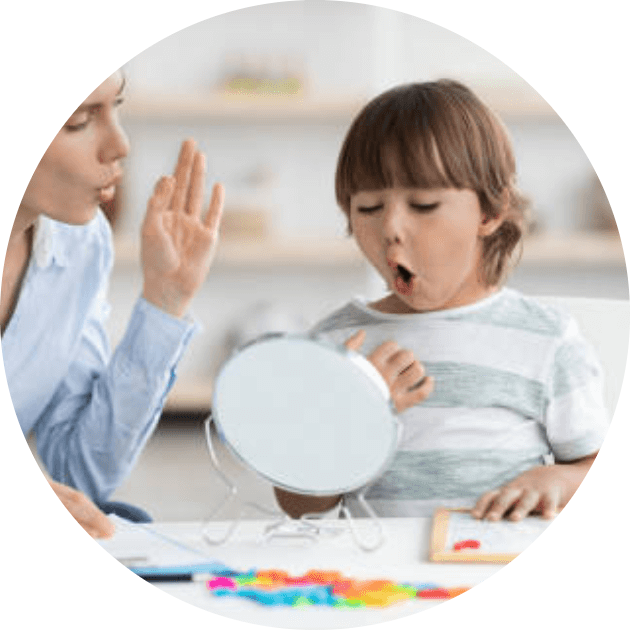
Childhood apraxia of speech (CAS) is a neurological disorder that affects an individual’s ability to produce speech sounds accurately and fluently. CAS is caused by difficulty planning and coordinating the muscle movements needed for speech, and is not caused by weakness or paralysis of the muscles used for speech.
Symptoms of CAS may include:
- Difficulty producing sounds: Children with CAS may have difficulty producing certain sounds or may not be able to say words or sounds correctly.
- Difficulty with the rhythm and flow of speech: Children with CAS may have difficulty with the rhythm and flow of speech, and may have a choppy or halting speech pattern.
- Difficulty with language skills: Children with CAS may have difficulty with language skills, such as understanding and using words and sentences.
Treatment of CAS
CAS can affect children of any age and can range in severity. Treatment for CAS typically involves speech therapy, which can help children improve their speech production skills and develop more effective communication strategies. In some cases, medications may be used to help manage specific symptoms of CAS, such as anxiety or hyperactivity. It is important to note that treatment for CAS is typically tailored to the individual’s specific needs and may involve a combination of therapies and interventions. A healthcare professional, such as a speech therapist or psychologist, can help develop an appropriate treatment plan.
Treatment for childhood apraxia of speech (CAS) typically involves speech therapy, which can help children improve their speech production skills and develop more effective communication strategies. The goals of speech therapy for CAS may include:
- Improving speech sound production: Speech therapy can help children with CAS learn to produce speech sounds more accurately and fluently. This may involve activities and exercises to help improve muscle control and coordination.
- Improving language skills: Speech therapy can also help children with CAS improve their language skills, such as understanding and using words and sentences.
- Developing compensatory strategies: Speech therapy can help children with CAS develop compensatory strategies, such as using gestures or visual aids, to help them communicate more effectively.
Here are a few exercises that may be beneficial for a child with Childhood Apraxia of Speech (CAS):
- Articulation exercises: Children with CAS often struggle with the physical movements needed to produce speech sounds correctly. Exercises that focus on the muscles of the face and mouth, such as blowing bubbles, blowing through a straw, or blowing up balloons, can help to improve the child’s ability to coordinate the movement of their speech muscles.
- Repetition exercises: Children with CAS may benefit from repeating words and phrases to improve their ability to coordinate the movements needed for speech. This can be done by repeating simple words or phrases, such as “mom” or “I want juice,” in isolation or in short phrases or sentences.
- Imitation exercises: Children with CAS may benefit from imitating the speech of others. The child can watch or listen to a model speak and then imitate what they hear. This can help to improve the child’s ability to coordinate the movements needed for speech.
- Auditory bombardment: The child listen to different words and phrases repeatedly, which exposes them to a wide range of sounds and words, which helps them in their development of speech sounds.
- Tactile cueing: Children with CAS may benefit from having a tactile cue to remind them of the correct position of the articulators. This can be done by placing an object such as a popsicle stick in the child’s mouth to remind them of the correct position for speech sounds.
- Motor planning exercises: Children with CAS struggle with planning and coordinating the muscle movements required for speech, so exercises that target this area can be helpful. this can be done by asking child to move their body in specific ways while they are saying a word or phrase, such as making big arm movements while saying the word “big” or touching their nose while saying “nose.”
Resources
- m B-R, SeoH-S, Ku J-M, et al. Silibinininhibits the production of pro-inflammatory cytokines through inhibition of NF-κB signaling pathway in HMC-1 human mast-cells. Inflammation. Research. 2013;62(11):941-950. doi:10.1007/s00011-013-0640-1.
- ChapowalA. PetasitesStudy Group. Randomisedcontrolled trial of butterbur and cetirizine for treating seasonal allergic rhinitis. BMJ 2002;324:144-6.
- Hayes, N. A. and Foreman, J. C. The activity of compounds extracted from feverfew on histamine release from rat mast-cells. J Pharm Pharmacol1987;39(6):466-470
- Hsieh et al. Baicalein inhibits IL-1ß- and TNF-a-induced inflammatory cytokine production from human mast-cells via regulation of the NF-?B pathway. ClinMolAllergy. 5: 5. 2007.
- TheoharidesTC, Patra P, Boucher W, et al. Chondroitin sulphateinhibits connective tissue mast-cells. British Journal of Pharmacology. 2000;131(6):1039-1049. doi:10.1038/ sj.bjp.0703672.
- Ro JY, Lee BC, Kim JY, et al. Inhibitory mechanism of aloe single component (alprogen) on mediator release in guinea pig lung mast-cells activated with specific antigenantibodyreactions. J PharmacolExpTher. 2000;292:114–121. 73.
- https://www.ncbi.nlm.nih.gov/pubmed/24477254
- https://www.ncbi.nlm.nih.gov/pubmed/28458279
- https://www.ncbi.nlm.nih.gov/pubmed/9421440
- https://www.ncbi.nlm.nih.gov/pubmed/10344773
- https://www.ncbi.nlm.nih.gov/pmc/articles/PMC4315779/

